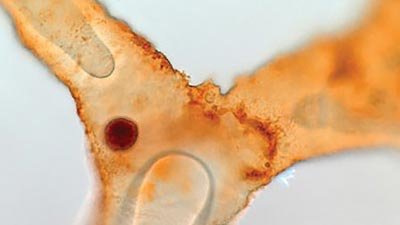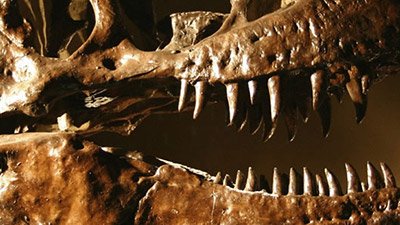
Group of Infant Dinosaurs Found In Fossilized Nest
Dinosaur babies frozen in time
News Source
- Yahoo! News: “15 Infant Dinosaurs Discovered Crowded in Nest”
Fifteen juvenile Protoceratops clustered in Tugrikin Shire, Mongolia, suggest this kind of dinosaur cared for its young. This find is the only undisputed Protoceratops nest known. Scientists thought they had found a nest of Protoceratops eggs in the 1920s, but the inhabitants turned out to be oviraptorids. Professor David Fastovky and colleagues describe these exceptionally well-preserved fossils in the November Journal of Paleontology.
Based on their proportionately large eyes and small snouts, juvenile bone structure, and lack of adult features like horns and frills, these dinosaurs appear to be juveniles.1 They’re all about the same size, 4–6 inches long, suggesting they are the same age, and they are positioned within a curved boundary suggestive of a nest.
Nevertheless, these dino-babies were probably not newly hatched. There is no eggshell material, which is commonly preserved in the fossil-rich Djadokhta Formation. Also, they are about 60 percent larger than a less-ossified—and therefore younger—specimen of the same kind found nearby. Since the dino-babies in this nest were “not neonates,”2 Fastovky’s team suspects their parents were involved in their care for some period of time.
The sandstone of the Upper Cretaceous Djadokhta Formation of the Gobi Desert has been the site of a number of phenomenally preserved specimens of mammals and dinosaurs. Exquisite preservation of fragile structures can only be explained by sudden rapid entombment.
Since the Gobi Desert area is now obviously a desert, not a marine environment, many scientists assume the fossils there died as a result of a sudden sandstorm. No doubt something had to catastrophically bury these creatures in sand. But other scientists have suggested the catastrophe involved burial by a load of waterborne sand. Waterborne sand could be brought in by flashfloods or, of course, by surging sediment-laden water associated with the global Flood. Thus, most creationists believe the evidence is consistent with these fossils being buried in these sandy layers during the Flood.
Fossils in the Djadokhta Formation are typically encased in random particles of sand. Sufficient sand was dumped to cover even large animals, whether “by land” or “by sea.” Fastovsky believes “The evidence suggests they may have been overrun by migrating dunes during a sandstorm.” Storms spawned by changing air and water temperatures would have raged during the Flood year. Thus, while the waters were still surging, violent wind could have caused dune avalanches and dropped loads of sand on these animals. Even so, the ultimate water-disaster was right on the heels of such a dune-disaster, with the floodwaters soon rising to cover everything.
The cross-bedding in the sandstone between Gobi fossil units is normally at the 25-degree angle consistent with underwater sand deposition, not the 30-34 degree angles seen with wind-deposited sand. Fastosky reports there was strong cross-bedding of the sandstone, but he does not report the angles of deposition.
Some Flood geology models have suggested dinosaurs could have laid eggs between the surges of rising water, and indeed they could have. However, the fact that the inhabitants of this dinosaur nursery are “not neonates”3 makes that a doubtful scenario for this particular “nest.” Without knowing the growth rate of Protoceratops, of course, we cannot completely rule it out.
Thus, the biblical Flood explains the preservation of this dinosaur “nest.” Genesis chapter 7 tells us that the Flood began when the fountains of the great deep opened along with the windows of heaven, in reference to volcanic activity and rain combining to violently cover the earth with water over a period of many weeks. The fossil graveyards of the Gobi with many creatures frozen in time were catastrophically buried in loads of sand dumped on them by violent winds and sediment-laden surges of floodwaters. Ultimately, water covered all, producing the characteristic cross-bedded striations typical of underwater sand-waves. The Upper Cretaceous layers are conventionally dated at about 70 million years based on unverifiable untestable assumptions from both radiometric dating methods and the evolutionary ages of the fossils in them, but God’s eyewitness account in the Bible tells us the Flood happened only about 4,500 years ago.
See photos of the dinosaur nursery.
For More Information: Get Answers
Remember, if you see a news story that might merit some attention, let us know about it! (Note: if the story originates from the Associated Press, FOX News, MSNBC, the New York Times, or another major national media outlet, we will most likely have already heard about it.) And thanks to all of our readers who have submitted great news tips to us. If you didn’t catch all the latest News to Know, why not take a look to see what you’ve missed?
(Please note that links will take you directly to the source. Answers in Genesis is not responsible for content on the websites to which we refer. For more information, please see our Privacy Policy.)
Footnotes
- Fastovsky, D. et al., “A Nest of Protoceratops andrewsi (Dinosauria, Ornithischia),” Journal of Paleontology 85, no. 6: 1035–1041.
- Ibid.
- Ibid.
Recommended Resources

Answers in Genesis is an apologetics ministry, dedicated to helping Christians defend their faith and proclaim the good news of Jesus Christ.
- Customer Service 800.778.3390
- © 2024 Answers in Genesis






